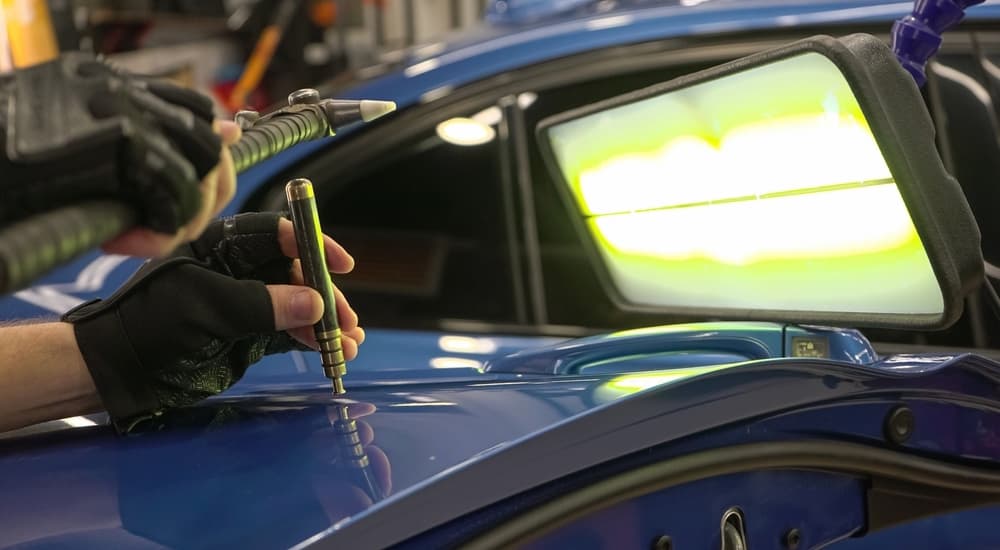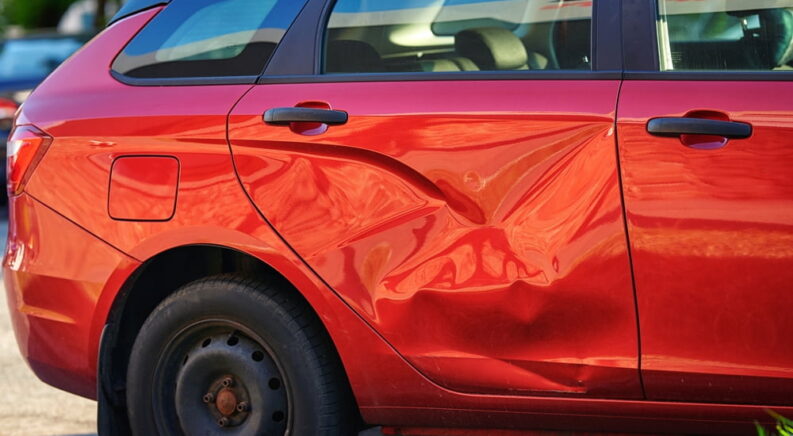No matter how safe a driver you might be or how observant you are when it comes to the rules of the road, the numbers aren’t on your side when it comes to auto accidents. There are over six million accidents on US roads every year, with the average American experiencing a collision three or four times over the course of their driving career. You might always check your blind spot, double-check when backing out of a grocery store parking lot, and use your signal every time you change lanes, but chances are you’ll eventually experience the dreaded dent. These dents can range from the superficial to the serious, which means there’s no one-size-fits-all solution for repair. What’s a driver to do when they find themselves on the wrong side of a foul ball, pedestrian barrier, or the bumper of an oncoming vehicle? In this article, we’ll review everything a driver needs to consider when contemplating a dent repair. From using insurance to taking the DIY approach, detailing the different types of dents and dent repair, and learning when to call in the pros, read on as we explore everything you need to know about the dent repair process.
Go With the Pros or DIY?
Drivers have a number of options when contemplating dent repair. Going the professional route is a popular choice but can also come with a high price tag. Repairs can cost anywhere between $75 to $150 for a minor dent and as much as $500 for a larger area. If the project involves repainting the vehicle, the price can easily skyrocket to as much as $1,000 to $2,500. Insurance can be helpful for these more expensive repairs, but if you’re looking at dent repair in the $100 to $300 range, it might be better to go it on your own. Most comprehensive insurance policies will cover dent repair, but it might not be worth the cost of the deductible and the potential impact on your premium. If another driver is found to be at fault for the damage, they’ll probably end up footing the bill. However, knowing what route to take can be a little trickier if you’re the one on the hook.
It never hurts to call and chat with your insurance company and explore all your options. It all depends on your specific policy, your confidence in your own repair skills, and whether or not the dent is large enough to warrant repair in the first place. If you’re driving a brand-new vehicle that just rolled off the lot and are looking to keep it in pristine shape for as long as possible in hopes of an eventual sale or trade-in, professional dent repair might be worth it. If, on the other hand, your vehicle has been around the block a few times and you expect to run it into the ground, you might want to try the DIY approach or skip out on repair altogether. That said, larger dents should always be inspected by a trusted mechanic as they could compromise the safe operation of the vehicle. It might look like only some surface damage, but depending on how deep the dent goes and whether or not the vehicle’s frame has been impacted, you could be putting yourself and other drivers at risk every time you sit behind the wheel.

Types of Dent Repair
Dent repairs can be broken down into two categories: paintless dent repair (PDR) and traditional dent repair. The first is a great option for the at-home mechanic, with PDR kits available for as low as $40 to $60. Traditional dent repair, which is normally performed at an auto body shop, is a different story entirely. This time- and labor-intensive process often yields the best results but can be costly. Let’s analyze some of the differences between PDR and traditional dent repair and see which is the right choice for your situation.
Paintless Dent Repair (PDR)
Ideal for small dents, PDR allows the average driver to tackle their dent repair project themselves at a fraction of what a professional shop might charge. The approach does have its drawbacks, but if you’re dealing with small dings or round dents, it might be the perfect option. PDR uses a simple set of tools to pull a dent right out of the panel. When tackling a smaller dent, it can be performed in as little as 30 minutes. Larger dents could take a couple of hours to repair, but as long as you have enough patience and are down to learn a new trick, it can be a valuable skill to develop. PDR is not a practical choice for creases and, as the name implies, can’t be used to address chipped paint. It also tends to work best when addressing dents on metal panels and is less effective on areas of the body that might be made out of aluminum or plastic.
Traditional Dent Repair
There are over 40,000 collision repair shops in the US alone, and there’s a good reason why. Larger dents, especially creased, sharp, and extreme dents, are usually beyond the purview of the DIY set. Instead of pulling out a dent like with PDR, traditional dent repair uses fillers, hammering, and sanding to restore a vehicle to its showroom condition. Auto body repair shops are also adept at the repainting portion of the dent repair process, using professional-grade tools to get a perfect match that can make even the deepest dent virtually disappear and provide long-term protection. In the case of extreme damage, an auto body shop might even replace an entire panel, though a surprising number of dents can be fixed with enough expertise and elbow grease. Traditional dent repair can be used to fix any sort of dent you might imagine, from the simplest scrape or bump to the wide-ranging damage that can result from a serious collision. The main downside of traditional dent repair comes down to time and cost. The process isn’t cheap, and even the best shop might need a few days to get the job done.
Types of Dents
Dents generally fall into four common categories. Each type needs to be addressed in a different way, with some often requiring professional intervention. Let’s review these four dents types and help determine if DIY dent repair will be possible.
Round Dents
Typically caused by an impact from a round object like a football, basketball, or hail, round dents are generally the easier type of dent to repair, thanks to the fact they’re often pretty symmetrical. PDR is usually a practical option in the event of a round dent, but some drivers have even found success with ever lower-tech approaches like a kettle of hot water and an off-the-shelf plunger.
Creased Dents
Creased dents occur when a vehicle makes contact with an object like a tree branch, wall, pole, or even another vehicle. As these objects are dragged across the surface of the car, they can leave a long, shallow dent that can cover one or more panels. Some creased dents can be handled by a capable DIY-er, but deeper or more complex creases might need a professional touch.
Sharp Dents
These dents are usually the result of another car’s door, rocks, or some other sharp, fast-moving object. Sharp dents are often small, but their depth and irregular shape can make them difficult to repair if you’re not well-versed in the world of dent repair. The type of impact that causes a sharp dent is also prone to taking off a little paint, so in many cases, PDR won’t be an option for these sorts of dents.
Extreme Dents
If you’ve ever been in an accident involving an animal, another vehicle, or even a person, you’re probably all too familiar with extreme dents. These dents tend to be large and irregular and might even span multiple panels, making home repair difficult. That’s not to say that all extreme dents are beyond the capability of the average driver. Still, getting a professional opinion is important as the damage can often be a little deeper than it might first appear. This is especially true when dealing with an accident that involves another vehicle.

Dent Repairs to Avoid
We’re champions of the DIY ethos here at CheckEngine and sincerely believe that a little research, the right tools, and a few good YouTube tutorials are the only thing standing between a driver and a workable vehicle repair. That said, there are some cases when going it alone isn’t the right option. When it comes to dent repair, there are some specific types you’ll want to avoid if you’re seeking anything close to a professional-looking result.
You’ll want to seek professional help for dents that involve extensive damage to the paint. Like regular painting, vehicle painting is an art. While small dents might be able to be hidden with a little touch-up paint, it’s often difficult to obtain a perfect match. Modern car paint is made up of five distinct layers, from the e-coat and primer to the base coat and clear coat. Replicating the work of a professional auto body repair shop in your driveway isn’t necessarily impossible, but it will often involve too many specialized tools and techniques to be worth your while.
Dents that cover one or more body panels are also worth leaving to the pros. These dents are going to be very difficult to address without the right tools, especially those that reach the edges of each panel. A dent that covers multiple panels is often going to be large enough that it’s worth getting your insurance involved, but it all comes down to how much importance you place on your vehicle’s curb appeal and your resale or trade intentions. Dents that bump up against critical vehicle components like headlights, wiring, or the frame should also be left to the pros. These dents could indicate a larger issue that could affect the safe operation of your vehicle, including the headlights, brakes, or other vital life-saving equipment.
Dent repair might seem intimidating, but it doesn’t have to be. It’s important to remember that a poorly performed dent repair job isn’t likely to impact the actual operation of your vehicle. While messing with the engine, tinkering with the transmission, or even changing the oil might be fraught with potential hazards, the worst possible outcome of a bad dent repair job is an unseemly blemish on the surface of the vehicle. Biting off more than you can chew can easily lead to some frustration, but if you do the appropriate triage and know what sort of dents are beyond your comfort level, DIY dent repair can be a great way to save a little cash. It’s also important to know when to get the professionals involved. Insurance can be a valuable asset when trying to address larger dents, but it might not be worth the cost if you’re dealing with a simple fender bender.

